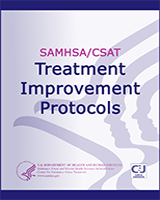NCBI Bookshelf. A service of the National Library of Medicine, National Institutes of Health.
This TIP, Substance Abuse Treatment and Domestic Violence, presents treatment providers with an introduction to the field of domestic violence. It gives providers useful information on the role of substance abuse in domestic violence—both among the men who batter and the women who are battered. Useful techniques for detecting and eliciting such information are supplied, along with ways to modify treatment to ensure victims' safety and to stop the cycle of violence in both parties' lives. Legal issues, including duty to warn and confidentiality, are discussed. Finally, the Panel provides a blueprint for a more integrated system of care that would enhance treatment for both problems. This section includes practical suggestions for establishing linkages both between substance abuse treatment providers and domestic violence support workers and with legal, health care, criminal justice, and other relevant service agencies.
Contents
- What Is a TIP?
- Editorial Advisory Board
- Consensus Panel
- Foreword
- Executive Summary and Recommendations
- Chapter 1—Effects of Domestic Violence on Substance Abuse Treatment
- Chapter 2—Survivors of Domestic Violence: An Overview
- Chapter 3 -- Batterers: An Overview
- Chapter 4—Screening and Referral of Survivors and Batterers in Substance Abuse Treatment Programs
- Chapter 5—Legal Issues
- Chapter 6 -- Linkages: A Coordinated Community Response
- Appendix A -- Bibliography
- Appendix B—Federal Confidentiality Regulations
- Appendix C—Instruments
- Appendix D—Sample Personalized Safety Plan For Domestic Violence Survivors
- Appendix E—Hotlines and Other Resources For Domestic Violence and Related Issues
- Appendix F—Resource Panel
- Appendix G—Field Reviewers
- Tables and Figures
This publication is part of the Substance Abuse Prevention and Treatment Block Grant technical assistance program. This publication was written under contract number ADM 270-95-0013. Sandra Clunies, MS, ICADC, served as the CSAT Government project officer. Writers were Paddy Cook, Constance Grant Gartner, MSW, Lise Markl, Randi Henderson, Margaret K Brooks, Esq, Donald Wesson, MD, Mary Lou Dogoloff, Virginia Vitzthum, and Elizabeth Hayes. Special thanks go to Daniel Vinson, MD, MSHP, Mim J Landry, Mary Smolenski, CRNP, EdD, MaryLou Leonard, Pamela Nicholson, Annie Thornton, Jack Rhode, Cecil Gross, Niyati Pandya, and Wendy Carter for their considerable contributions to this document.
The opinions expressed herein are the views of the Consensus Panel members and do not reflect the official position of CSAT, SAMHSA, or the U.S. Department of Health and Human Services (DHHS). No official support or endorsement of CSAT, SAMHSA, or DHHS for these opinions or for particular instruments or software that may be described in this document is intended or should be inferred. The guidelines in this document should not be considered substitutes for individualized patient care and treatment decisions.
